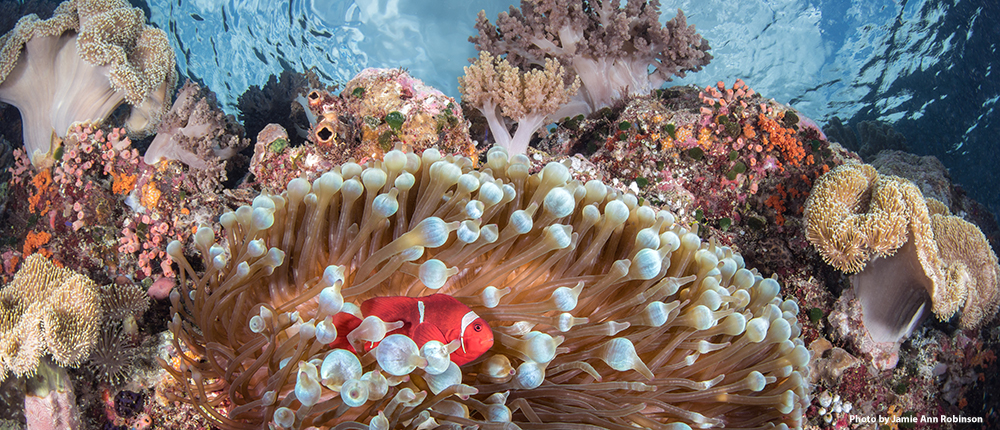Wakatobi’s Shallow Water Paradise
Wakatobi is known as one of the world’s premier dive destinations. But as a growing number of guests have discovered, you don’t need to don SCUBA gear to experience the magic of the surrounding reefs. That’s because many of the same sites that wow divers are equally delightful when explored at snorkeling depths.
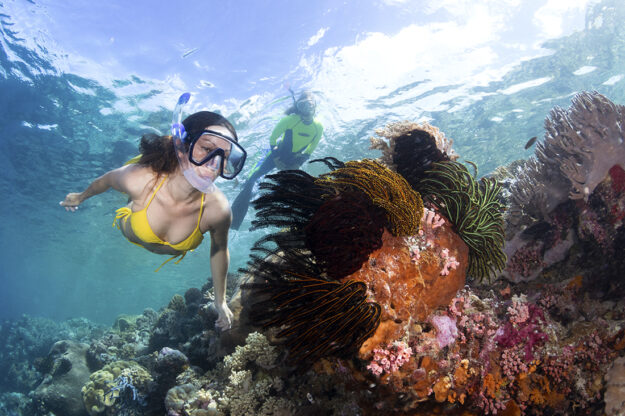
Snorkelers have numerous world-class options to choose from when they don mask and fins and enter the waters of Wakatobi. Photo by Walt Stearns
The appeal of snorkeling takes many forms at Wakatobi. It can provide a pleasant addition to daily dive plans, a complete alternative to tanks and gear, or a unique opportunity for couples and families that are a mix of divers and snorkelers to share the same underwater sights and adventures. “I am a scuba diver as is my husband,” says guest Mary Arman. “We have been to Wakatobi three times [and will be returning in Sept 2024]. Due to a health condition, I cannot make back-to-back dives. Snorkeling during rest intervals allows me to spend more time in the water and get the most from my vacation. At Wakatobi, we go out on the dive/snorkel boats together; I snorkel the site with a guide while my husband dives. This is something we have not found we could do at any other destination.” ~ Mary Arman
A World’s Best: the Wakatobi House Reef
One of the world’s finest snorkel sites can be seen from the front porches of Wakatobi’s Ocean Bungalows and Villa Decks. Just beyond the beach, the House Reef beckons with an enticing liquid pallet of ambers, aquamarines, and blues that hint at what lies below the surface. “The volume of fish and wildlife just under the surface and around the front of the resort is amazing,” says guest Barbara Pratt. “We loved being able to just wade in right from the villa steps, having it all right there at our doorstep.”
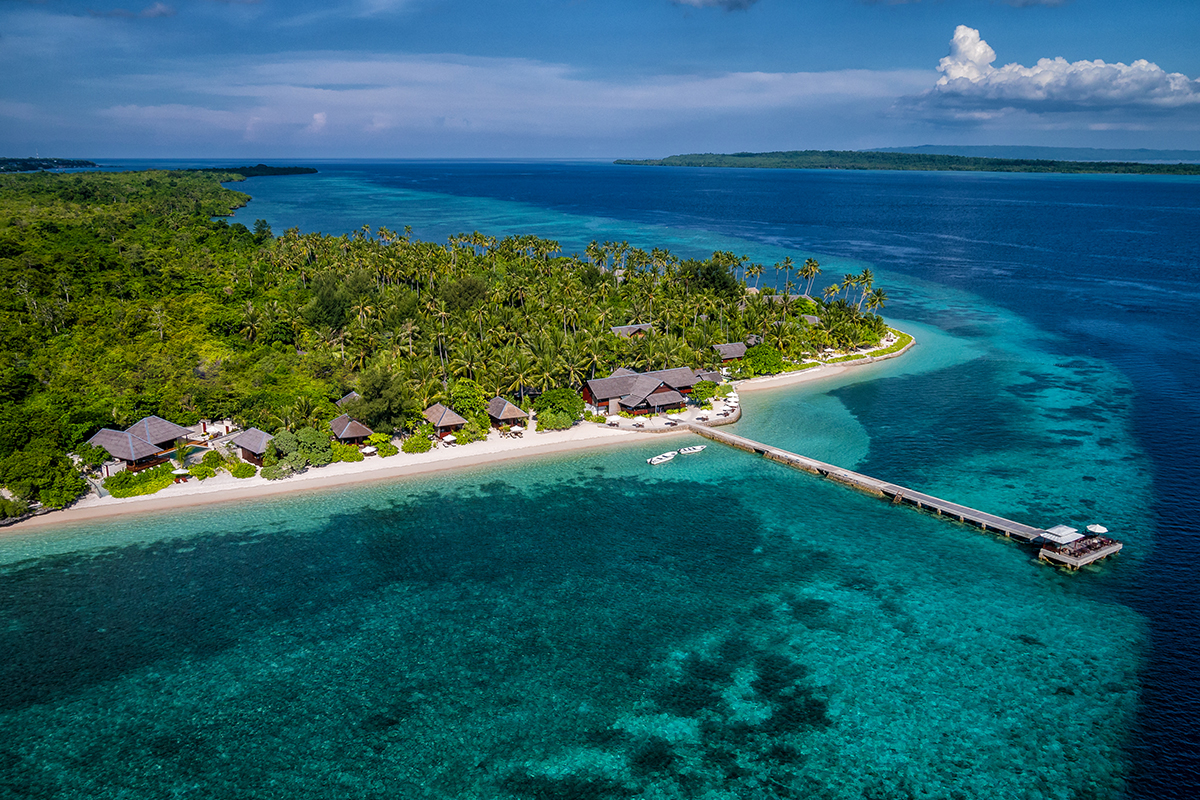
Just beyond the beach, the Wakatobi House Reef beckons with an enticing palette of color and unique marine life. Photo by Didi Lotze
The House Reef not only encompasses a large expanse of coral structure, but also a diverse range of shallow-water ecosystems, including sand flats, grass beds, debris fields, patch reefs, and of course, the outer reef itself, which rises to within mere meters of the surface before plummeting into the depths. While divers typically focus on the slopes and walls of the reef, snorkelers are actually better equipped to explore the vast areas between shore and slope, as they can glide over shallow formations without the encumbrances of tank and gear and need never worry about air consumption or bottom times.
“The House Reef offers lots of surprises, with so much variety for snorkelers,” says guest Yvonne Streit. “We could spend days there and have a different experience each time. We could be independent but always felt protected and observed by the staff.” Access is easy, as there are no schedules to adhere to, and one can simply wade out from the beach, enter off the jetty ladder, or ask for a resort taxi boat to ferry you to more distant portions of the reef.
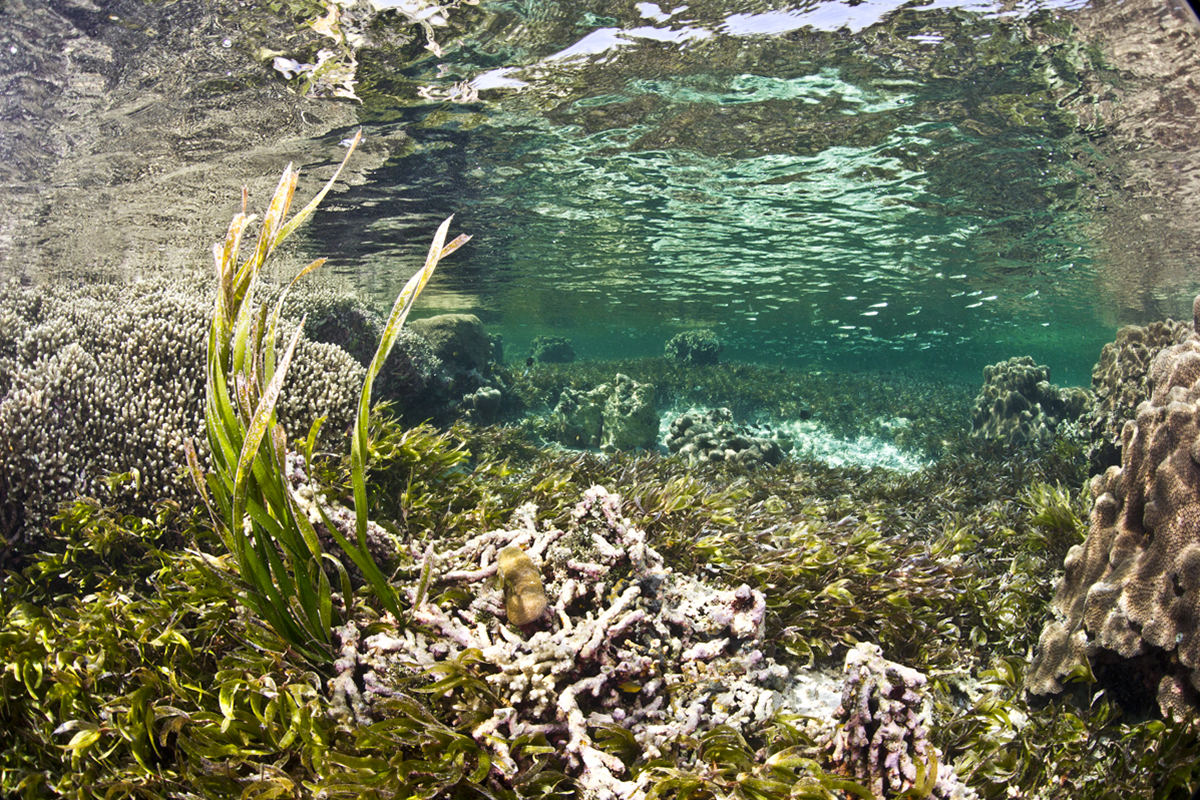
Just a few fin strokes from shore, snorkelers will find meadows of seagrass harboring a menagerie of unique and curious life. Photo by Warren Baverstock
Many snorkelers begin their swims at the resort’s jetty, which provides easy access to the water in all tide conditions and is a fecund environment for marine life. Around the jetty, the underwater scene changes through the day and with the tide. Snorkelers can always count on seeing the mantles of giant clams and a wealth of colorful anemones filled with the attendant life forms that find shelter among the tentacles. With ample sunlight, the upper rim of the reef reveals a cornucopia of macro life hiding among the hard and soft corals.
“We’ve done a fair bit of snorkeling throughout the world and Wakatobi is by far the best,” says guest John Pratt. “The pristine coral, fish, the colors, the clear water… it all exceeded our expectations.”
A few fin strokes toward the shore carries snorkelers into a very different world, one where meadows of seagrass and small coral heads provide a safe haven for a wide variety of juvenile reef fish, as well as a rich environment for odd and beautiful creatures such as frogfish, stonefish, blue-ringed octopus, moray eels, blue-spotted stingrays, ghost pipefish, jawfish, shrimp and goby pairs.
Welcome aboard
While Wakatobi’s House Reef is justifiably famous, it is by no means the only choice for snorkelers. By hopping aboard one of the resort’s dive boats, snorkelers can gain access to dozens of additional sites. One preferential favorite snorkel destination that is just a short boat ride away from the resort is Turkey Beach. This site is best known for its resident population of sea turtles, which can be often found gliding along the edge of the drop-off. In addition to the turtles, is a wide variety of fish life, including eagle rays and bumphead parrotfish. The underwater terrain consists of a series of ridges riddled with shallow overhangs and undercuts festooned in hard and soft corals.

Snorkelers who join the morning and afternoon boat excursions are accompanied by a professional snorkel guide who is versed in the marine life found on our reefs. Photo by Glen Cowans
Turtles sit on the ridges and the current gathers schools of fish at each crest, while the valleys in between hold swirling schools of batfish and bronze snappers. Snorkeling above this undulating terrain can create an awe-inspiring sense of flight, especially when there is a current running. A favorite way to enjoy this site is to arrive by taxi boat and perform an extended drift with the current back to the resort, exiting at the jetty.
Another east-end site that offers rewards at shallow depths is the patch reef known as The Zoo, which lies just beyond Turkey Beach. “It was excellent when we went out on the boat to snorkel,” says guest Simon Streit. “We had our own snorkel guide. He drew pictures of the sites and explained what specific fish and corals we’d see; it was very informative.”
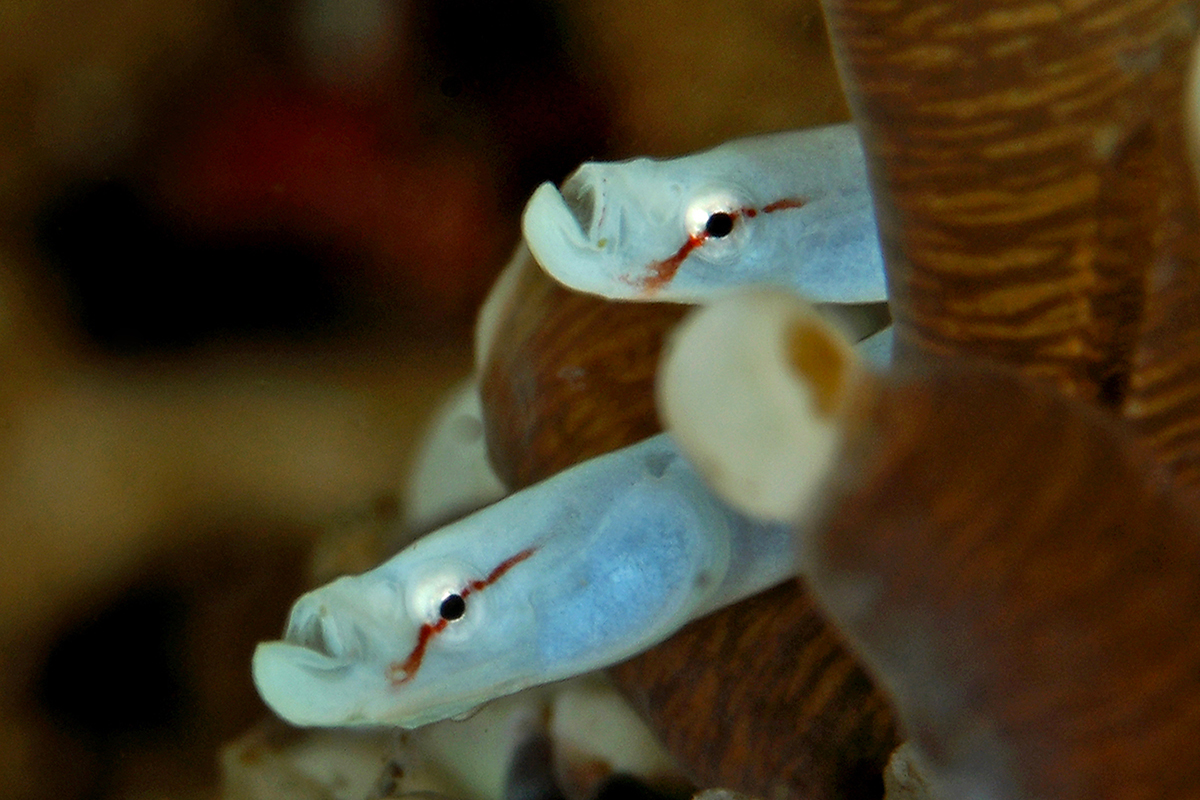
One of the more intriguing small animals that can be viewed by snorkelers at The Zoo is the mushroom pipefish. Photo by Wakatobi Resort
Snorkelers looking to hone their photography skills will find a plenitude of subjects at The Zoo within a meter or two of the surface. Among the resident species hiding among the corals are frogfish, ghost pipefish, mantis shrimp, leaf fish, funky hairy squat lobster, and more. One of the more intriguing small animals found at this site are mushroom pipefish. As the name implies, these creatures lurk near mushroom anemones. This small white pipefish has a triangular head, which makes it look less like a pipefish and more like a small underwater python.
Western Wakatobi favorites
Just beyond the western edge of the resort, the reef’s rampart-like slope transitions to a series of seamounts. One of the most scenic of these underwater mountains is Table Coral City. This formation rises from depths of 30 meters to within two meters of the surface, with upper slopes covered in huge plates of the site’s namesake table corals, along with patches of cabbage coral and fields of staghorn coral.
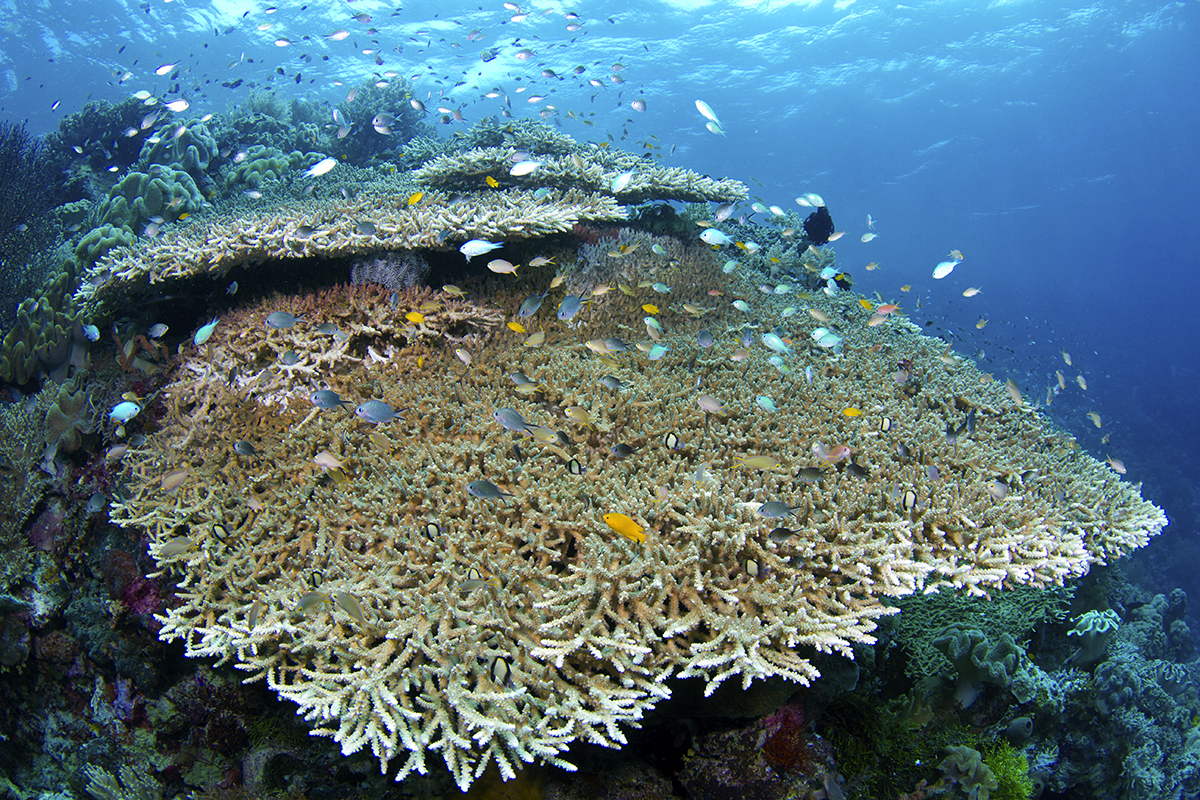
Table Coral City is one of the most scenic seamounts on the western edge of the resort where the site’s huge plates of corals rise to within two meters of the surface. Photo by Walt Stearns
A school of chevron barracuda circles the mound, giant trevallies hunt in the shallows, and the entire top is at times covered in swirling anthias. The list of resident species also includes schools of snappers, turtles, ribbon eels, frogfish, and octopus.
Another favorite snorkeling venue that lies to the north of Table Coral City is the seamount known as Roma. This site offers divers a range of habitats within a relatively small area. The shallow top of the pinnacle encompasses a small sandy area that is fringed with a beautiful patch of stony coral and adorned with anemones and clownfish. To one side lies a large expanse of pavona coral that shelters a plethora of reef fishes. On the opposite side of the mount lies a drop-off fringed with table corals, soft corals, and fans. Around this slope swirl schools of fusiliers, pyramid butterflyfish, sergeant majors, houndfish, and redtoothed triggerfish, while banded sea snakes can be found poking around the coral, foraging for food. Macro life at this site includes ribbon eels, scorpion leaf fish, winged pipefish, spindle cowries, carpet anemone shrimps, and rockmover wrasses. Whether they are simply fish watching or using a camera to capture keepsake images, this site has everything needed to keep snorkelers enthralled.
Broader Horizons
There are more than a dozen additional exceptional snorkel sites within a half-hour’s boat ride of the resort. The list includes venues such as Magnifica, Lorenz’s Delight, Pastel Reef, and Pinki’s Wall. Each of these sites has its unique features, but also share similarities, as they are located along the western edge of the expansive Sawa reef system. While divers focus on the drop, snorkelers can spend hours wandering around the shallow plateau above. At Fan Garden, for example, a large number of multi-colored sea fans undulate in the sunlight, beckoning snorkelers to come in search of the many small creatures that hover, dart, or hide among the fronds. Farther to the south, Lorenzo’s Delight brings the reef right to the facemask, with coral formations that continue upward to within two feet of the surface. This creates an excellent opportunity for snorkelers to focus on the tiniest of animals that might otherwise be missed at greater depths.
One could devote entire days to exploring the shallows of Sawa Reef, and more adventurous snorkelers might even opt to join divers at one of the more distant walls or seamounts visited by the dive boats. Ultimately, most snorkelers will find themselves combining boat trips with time on the House Reef, where there are no schedules to keep, and no time limits other than one’s personal interest and the lure of a savory meal that awaits ashore.
“We’re looking forward to much more time in the water on our next trip,” says Tara Rebele. “Based on our experience at other resorts, we didn’t think that there would be enough interest to justify multiple snorkel excursions every day. But with the excellent crew and underwater diversity of Wakatobi, we discovered that we couldn’t get enough. We’re going to fill our schedule with snorkel excursions next time!”
Calling all snorkelers! It’s time you too enjoyed the reefs of Wakatobi. Contact us at office@wakatobi.com or complete a quick trip inquiry at wakatobi.com.


